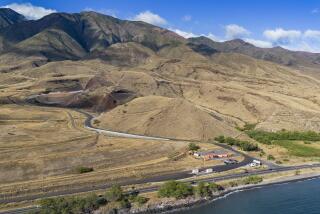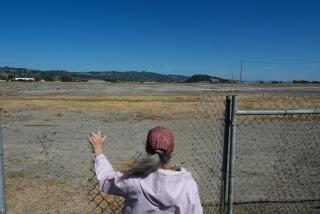Study Finds Nearness to BKK Dump, Body Stress Are Not Linked
- Share via
Residents living within a mile of the BKK toxic waste dump in West Covina show no greater incidence of stress-related headaches, nausea, loss of sleep and lost work days than those who lived as far as 10 miles away, a newly released federally funded study has found.
The study also reports widespread distrust among residents of local and state government statements about the possible health dangers posed by BKK. In addition, the study found concerns about the quality of life that equaled or exceeded those among Pennsylvania residents living near the Three Mile Island nuclear power plant in the aftermath of the nation’s worst nuclear power plant accident in March, 1979.
However, the study’s most prominent finding--and one that surprised researchers--was that there were no significant differences in stress-related bodily effects between residents who live adjacent to the dump and those who live as far away as 10 miles.
“Despite the public outcry and anecdotal evidence of health impairments, the objective conclusion is that there were no significant somatic (bodily) effects for those living closer to the landfill nor for those experiencing frequent visual and olfactory stimuli,” the study says.
Widespread Belief
The findings, which will soon be forwarded to the state Department of Health Services, appear to contradict a seemingly widespread belief that toxic dumps cause stress-related symptoms, such as headaches and loss of sleep among nearby residents. The findings were based on telephone interviews last December and January with 421 residents living at various distances from the BKK landfill.
The study did not deal with questions about cancer risks, birth deformities or ground water pollution.
The BKK dump, long the subject of investigations by the U.S. Environmental Protection Agency and local authorities, attracted widespread attention in mid-1984, when 21 nearby families were forced to evacuate because of methane gas migrating from the dump. A year ago, BKK stopped accepting extremely hazardous wastes. It still accepts non-hazardous waste.
The study was conducted by Claremont graduate student Michael Stefanko in association with the Center for Applied Social Research at the Claremont Graduate School. The project was underwritten by a $19,000 grant from the federal government’s Center for Mental Health Studies of Emergencies, an arm of the National Institute for Mental Health.
Data Analysis
Stefanko, 37, also is a lecturer in data analysis and general psychology at California State University, Long Beach, and California Polytechnic State University, Pomona. He holds master’s degrees in psychology and religious education and is an associate of the American Psychological Assn.’s population and environment division. In an interview, Stefanko said the results on stress-caused physical symptoms came as a surprise, because he said researchers expected to find “significantly higher behavioral effects” among those living closer to the landfill, based on complaints aired by residents at public meetings, accounts in the news media and previous stress studies elsewhere.
“We really expected people who lived south and west of the dump to report a lot more problems, because the dump is more visually stark. You can see many more trucks coming from the south, and the odors tend to go in that direction,” Stefanko said. “And yet, there were no differences. . . . People in Baldwin Park reported no more problems and symptoms than those living 1 1/2 miles from the dump and down wind from it.”
Nuclear Facility
The vast majority of respondents in the BKK study, 79%, reported low or very low levels of stress-related physical problems. In the case of Three Mile Island, people living within five miles of the nuclear power plant reported much higher levels of stress symptoms than those who lived farther from the facility.
Stefanko said he concluded that people are better able to cope with a long-term threat, such as living near a toxic waste dump, than they are with an immediate and traumatic event, such as the sudden and unexpected release of radioactivity at Three Mile Island.
“From the standpoint of stress, it appears that people are more than adequately able to cope with living near a landfill,” he said.
Stefanko, whose family lives within two miles of the BKK dump, said he was not concerned that his findings may appear to minimize possible dangers of living in the area.
“I feel that what we found was very objective. . . . It was never intended to be in favor of one group or the other. In fact, it should give comfort to some of the people living around BKK, as far as facing their potential stress problems. But it (the study) certainly does not detract from some of their concerns about carcinogens and water contamination.”
Survey Portion
He said the BKK dump was not raised until interviewers had completed a portion of the survey dealing with stress-related symptoms.
When respondents were asked their opinions as to how truthful they felt officials had been in talking about BKK or its possible health effects, high levels of distrust were found.
“The feeling that you get from that is people are distrustful of the government in general. But, the questions were phrased in the context of BKK, so specifically everyone was distrustful when the government talked about the landfill,” he said.
He added: “The study indicates that there needs to be constant and very open communication and education on the part of government for the people living near landfills. There needs to be a lot more information given out to the people on a regular basis and not just waiting until people are upset and a problem arises.
‘More Vulnerable’
“In particular, the study indicates that parents of small children, those with lesser education, the younger and those who are renters are more vulnerable, and therefore, education should be particularly directed toward them.”
According to the study, residents near BKK were slightly more negative than Three Mile Island residents when it came to concerns about health threats, and “substantially more negative” about the quality of life than were those near Three Mile Island.
“Both mothers and fathers of small children of the BKK sample were as negative (about the quality of life) as the mothers of small children in the TMI sample,” the study said.
While people living closer to the dump reported no significantly greater problems with stress-related physical symptoms, those living closer felt decidedly more threatened.
“These effects are again more pronounced among younger persons, females and those with small children,” the study says.
More to Read
Sign up for Essential California
The most important California stories and recommendations in your inbox every morning.
You may occasionally receive promotional content from the Los Angeles Times.










